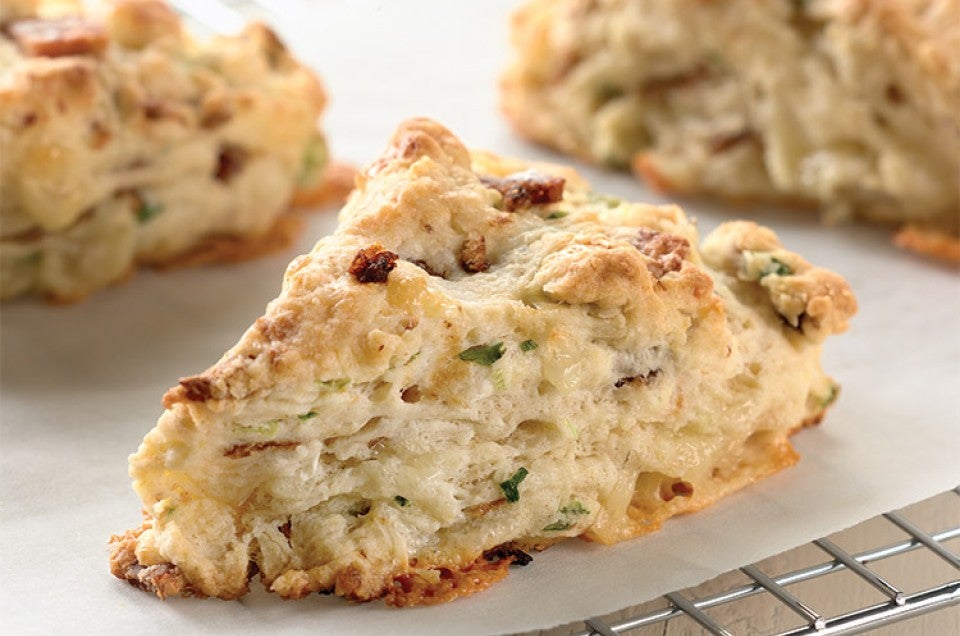


Savory scones? Not an oxymoron. Scones don’t have to be made with sugar and spice and everything nice. They can be made with smoky bacon, and cheese, and aromatic scallions… like these.
Reader Kathleen May recently wrote suggesting that I try to duplicate the over-the-top bacon, cheddar & scallion scones sold at the Atlantic Baking Co. (familiarly known as ABC), a bakery in Rockland, Maine, a town midway up Maine’s stunning 3,478-mile coast. Of course, my competitive urges kicked in. Just as with Berger Cookies (“Baltimore’s Finest”), or Grùyere-Stuffed Cheese Loaves (“Hot Cheese Bread”), where I simply had to figure out how to do it yourself—these scones piqued my imagination.
I explored ABC's Web site, hoping to find a picture of these wondrous, soon-to-be-imitated scones. No luck, though I did find a short description: “Bacon Cheddar Scallion Scones—Our cream scones with a savory twist.” Ah-HA! Clue #1. They’re made with cream. I also found a picture of their fruit scones, which were made in the traditional wedge shape. So that was Clue #2. But beyond that—well, it was time for my imagination to take over.
As it turned out, I really didn’t need much imagination to make this happy dream come true. A cream-based biscuit dough, with a bit of butter for flakiness. And in the dough, cooked, crumbled bacon; coarsely crumbled cheddar cheese; and snipped chives or scallions. Very straightforward. All I had to do was put the ingredients in a bowl, and they practically threw themselves at one another. It was love at first sight. And later, love at first bite.
I ran the recipe past Kathleen, my virtual judge. She told me she thought they had more filling than ABC’s, but sounded similar. So, anyone who’s up around Maine this summer, if you get to Rockland—ABC is at 351 Main Street. “Come in and enjoy Maine’s wonderful sunny days with the smell of the sea at your back,” says their Web site. I can vouch for that—I lived 5 miles from Rockland for 15 years, and well remember the smell of the sea. Next time I go, I’ll see if I can also pick up the faint scent of bacon scones in the air…
So I'm ready to make these scones on a Saturday morning, and realized I'd forgotten to buy chives or scallions. DARN! Back to the store. For some reason, I decided to take the elevator rather than the stairs, pressed the button, the door swings open... and there's two pots of chives sitting in the elevator. Really, I kid you not! I figured whoever they belonged to wouldn't mind me snipping off a few stems. As it turned out, my fellow blogger Susan Reid had brought them in from her garden on Friday, and mistakenly left them in the elevator. Great karma!
Next, the bacon. When you don't feel like standing over a grease-sputtering frying pan, lay the strips on a parchment-lined baking sheet, and bake them instead.
Chunk the cheese, and put it in a food processor. A mini-processor is handy, if you have one.
Process it just enough to make small, irregular chunks. If you don't have a processor, just grate the cheese coarsely.
Snip the chives or scallions. I use my handy scissors (not kitchen shears; regular scissors) for everything from chunking tomatoes to snipping scallions to slicing pizza to cutting chicken preparatory to stir-frying.
Next, whisk together the dry ingredients.
When the bacon is nicely browned, take it out of the oven.
I had this theory that it might be easy to put together scone dough in a gallon-size zip-top freezer bag. So I put the dry ingredients, plus cheese, chives, and bacon, into the bag.
I rolled it all a few times, to flatten/smear the butter cubes and work them into the flour. This method of working butter into flour to make pastry actually has a name: “frissage,” pronounced free-SAHJ. Go ahead, impress your friends with this knowledge next time you're talking about scones or piecrust.
Next, the cream goes into the bag.
I squashed it around with my hands till it was well combined.
Then dumped everything out on my floured silicone mat.
Was this method easier or better than just doing it all in a bowl? Well, it probably wasn't easier, though the cleanup was less. But smearing the butter into the flour and working the dough very minimally might have made a more tender scone. Since I didn't do a side-by-side test I can't be sure, but it was a fun experiment. Give it a try sometime when you're making scones or biscuits or piecrust, anything where you work the butter into the flour.
Gather the dough into a smooth ball...
...and flatten it into a 7” circle, about 3/4” thick. Transfer the dough to a parchment-lined baking sheet. You don't absolutely have to use parchment, but it makes cleanup really easy.
...and separate each wedge, so they're not touching. Then brush with a bit of cream or milk; this will help the scones brown.
Into a 425°F oven, and 25 minutes later, golden, bacony-cheesy scones.
These are RICH. A special-occasion treat for sure. Absolutely delightful. Thanks to reader Kathleen May, and the Atlantic Baking Company of Rockland, Maine, for the inspiration!
Read, review, and rate (please!) our recipe for Bacon-Cheddar-Chive Scones.

